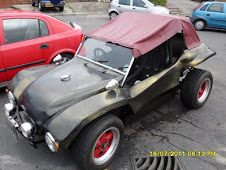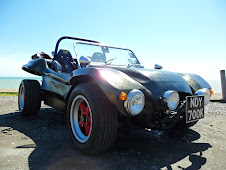 3rd January 2010
3rd January 2010The buggy was housed nicely in a friends garage and the snow was starting to flurry when a call came in this morning.
I got to the garage and we pulled the buggy out . I had decided that the 80mm body lift kit would need to be drilled before it was to be blasted and Zinc plated. This meant it had to be accurately positioned on the bare chassis. So that the holes in the buggy floor pan could be marked with a felt pen. This would have been easy if I had remembered to take a felt pen and my friend had not bought some from the pound shop.
We finally found a working felt and marked up the holes after taking measurements across the chassis to ensure that the frame was central. The body lift kit was then removed and the marks were spot marked with a punch and a hammer. I had previously used 8mm bolts to hold my chassis to my body and after a short discussion we both decided that 10mm bolts would be a better bet. new I would need 22 x 120mm x 10mm to bolt down the body through the body lift kit and chassis.
The position of the bolt holes that had been transferred to the chassis where then pre-drilled with a 6mm High Speed metal drill bit at a slowish drill speed.
Once the holes on one side was pre-drilled they where drilled using larger sizes until a 12mm hole was achieved. The body lift kit was then placed back onto the chassis with the body work on top of it so that the holes from the body work could be marked. These were spot marked with a punch in the same manner as the underneath holes. The drilling process was then repeated leaving a hole on the top and bottom of the lift kit. Once this was done the 12mm drill was then used to run through both holes to ensure that a bolt would navigate through.
With the hoes drilled it was noticeable that the body work looked
 untidy and overhung the body lift kit. The body work was marked were it over-hanged the lift kit . This was then trimmed off by my friend with a jigsaw so that it neatly sat along the inside. The picture to the right shows the underneath of the body work it also shows the areas that I had cut out to fit the traction bar. I would need to finish repairing these areas at a later date.
untidy and overhung the body lift kit. The body work was marked were it over-hanged the lift kit . This was then trimmed off by my friend with a jigsaw so that it neatly sat along the inside. The picture to the right shows the underneath of the body work it also shows the areas that I had cut out to fit the traction bar. I would need to finish repairing these areas at a later date.W
 ith the snow starting to flurry harder we placed the chassis and the body back in the garage and turned our attention to the troublesome engine. There was a large amount of power all over the clutch which looked as if the clutch had been slipping. The clutch cover plate was removed by undoing the bolts that run round the outside of it as the clutch pressure plate came of the clutch plate shattered into bits on the ground. Luckily both the clutch pressure plate and the fly wheel seemed to be unscathed with no damage. I asked my friend if he had a bar that we could try to turn the engine over with. Amazingly the engine seemed to rotate. It got as far as the number one firing position on the distributor and would not go any further. Counter rotating it allowed it to turn freely round to the number three firing position. This seemed very perplexing . We wondered if a gudgeon pin had come out. But the real reason probably would only been seen when the engine was took apart. In the mean time I had to get the body lift kit blasted and zinc plated.
ith the snow starting to flurry harder we placed the chassis and the body back in the garage and turned our attention to the troublesome engine. There was a large amount of power all over the clutch which looked as if the clutch had been slipping. The clutch cover plate was removed by undoing the bolts that run round the outside of it as the clutch pressure plate came of the clutch plate shattered into bits on the ground. Luckily both the clutch pressure plate and the fly wheel seemed to be unscathed with no damage. I asked my friend if he had a bar that we could try to turn the engine over with. Amazingly the engine seemed to rotate. It got as far as the number one firing position on the distributor and would not go any further. Counter rotating it allowed it to turn freely round to the number three firing position. This seemed very perplexing . We wondered if a gudgeon pin had come out. But the real reason probably would only been seen when the engine was took apart. In the mean time I had to get the body lift kit blasted and zinc plated.






















No comments:
Post a Comment